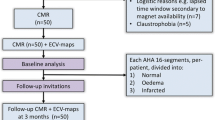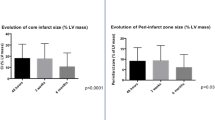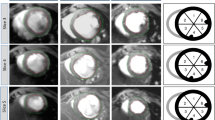Abstract
Object
To analyze the remodeling processes of the infarct territory in the time course of infarct healing.
Materials and methods
Serial late enhancement (LE) studies were performed in 30 patients following reperfused myocardial infarction (MI) in the first and second week post-MI and after 3 months. To characterize infarct remodeling over time, the following variables were derived and analyzed in a blinded fashion: Infarct size (IS, in mm3), maximum infarct thickness (ITmax, mm), mean infarct thickness (ITmean, mm) and the variability of infarct thickness (VIT=ITmax/ITmean). Further, a new parameter for the assessment of infarct remodeling, the infarct extent (IE, mm2) was computed. IE quantifies IS in two dimensions along the heart’s circumferential and longitudinal directions. IS was divided by the IE to obtain ITmean.
Results
Overall infarct thickness was highly variable. Infarct shrinkage due to infarct thinning and IE reduction was found in the first months of healing. IS, ITmean and ITmax significantly decreased during follow-up. There was a less consistent change of the IE: IE decreased in 75% of all infarcts from the first week up to 3 months post-MI, whereas 25% of infarcts expanded. Infarct thinning was found in almost all patients (92%), hence occurring in patients with infarct expansion and in patients without infarct expansion.
Conclusion
Infarct thinning and—to a lesser extent—IE reduction, contribute to infarct shrinkage in the time course of infarct healing. Infarct thinning may occur without infarct expansion.
Similar content being viewed by others
Abbreviations
- LE:
-
Late enhancement
- MI:
-
Myocardial infarction
- IS:
-
Infarct size
- IE:
-
Infarct extent
- ITmax :
-
Maximum radial infarct thickness
- ITmean :
-
Mean radial infarct thickness
- VIT:
-
Variability of infarct thickness
- C:
-
Circumferential extent of infarct
References
Pfeffer MA, Braunwald E (1990) Ventricular remodeling after myocardial infarction. Experimental observations and clinical implications. Circulation 81(4): 1161–1172
Hutchins GM, Bulkley BH (1978) Infarct expansion versus extension: two different complications of acute myocardial infarction. Am J Cardiol 41(7): 1127–1132
Weisman HF, Bush DE, Mannisi JA, Bulkley BH (1985) Global cardiac remodeling after acute myocardial infarction: a study in the rat model. J Am Coll Cardiol 5(6): 1355–1362
McKay RG, Pfeffer MA, Pasternak RC, Markis JE, Come PC, Nakao S, Alderman JD, Ferguson JJ, Safian RD, Grossman W (1986) Left ventricular remodeling after myocardial infarction: a corollary to infarct expansion. Circulation 74(4): 693–702
Gaudron P, Eilles C, Kugler I, Ertl G (1993) Progressive left ventricular dysfunction and remodeling after myocardial infarction. Potential mechanisms and early predictors. Circulation 87(3): 755–763
Moon JC, De Arenaza DP, Elkington AG, Taneja AK, John AS, Wang D, Janardhanan R, Senior R, Lahiri A, Poole-Wilson PA, Pennell DJ (2004) The pathologic basis of Q-wave and non-Q-wave myocardial infarction: a cardiovascular magnetic resonance study. J Am Coll Cardiol 44(3): 554–560
Fieno DS, Kim RJ, Chen EL, Lomasney JW, Klocke FJ, Judd RM (2000) Contrast-enhanced magnetic resonance imaging of myocardium at risk: distinction between reversible and irreversible injury throughout infarct healing. J Am Coll Cardiol 36(6): 1985–1991
Rehwald WG, Fieno DS, Chen EL, Kim RJ, Judd RM (2002) Myocardial magnetic resonance imaging contrast agent concentrations after reversible and irreversible ischemic injury. Circulation 105(2): 224–229
Wu E, Judd RM, Vargas JD, Klocke FJ, Bonow RO, Kim RJ (2001) Visualisation of presence, location, and transmural extent of healed Q-wave and non-Q-wave myocardial infarction. Lancet 357(9249): 21–28
Wagner A, Mahrholdt H, Holly TA, Elliott MD, Regenfus M, Parker M, Klocke FJ, Bonow RO, Kim RJ, Judd RM (2003) Contrast-enhanced MRI and routine single photon emission computed tomography (SPECT) perfusion imaging for detection of subendocardial myocardial infarcts: an imaging study. Lancet 361(9355): 374–379
Fieno DS, Hillenbrand HB, Rehwald WG, Harris KR, Decker RS, Parker MA, Klocke FJ, Kim RJ, Judd RM (2004) Infarct resorption, compensatory hypertrophy, and differing patterns of ventricular remodeling following myocardial infarctions of varying size. J Am Coll Cardiol 43(11): 2124–2131
Theroux P, Ross J Jr, Franklin D, Covell JW, Bloor CM, Sasayama S (1977) Regional myocardial function and dimensions early and late after myocardial infarction in the unanesthetized dog. Circ Res 40(2): 158–165
Ingkanisorn WP, Rhoads KL, Aletras AH, Kellman P, Arai AE (2004) Gadolinium delayed enhancement cardiovascular magnetic resonance correlates with clinical measures of myocardial infarction. J Am Coll Cardiol 43(12): 2253–2259
Hombach V, Grebe O, Merkle N, Waldenmaier S, Hoher M, Kochs M, Wohrle J, Kestler HA (2005) Sequelae of acute myocardial infarction regarding cardiac structure and function and their prognostic significance as assessed by magnetic resonance imaging. Eur Heart J 26(6): 549–557
Choi KM, Kim RJ, Gubernikoff G, Vargas JD, Parker M, Judd RM (2001) Transmural extent of acute myocardial infarction predicts long-term improvement in contractile function. Circulation 104(10): 1101–1107
Simonetti OP, Kim RJ, Fieno DS, Hillenbrand HB, Wu E, Bundy JM, Finn JP, Judd RM (2001) An improved MR imaging technique for the visualization of myocardial infarction. Radiology 218(1): 215–223
Reimer KA, Jennings RB (1979) The changing anatomic reference base of evolving myocardial infarction. Underestimation of myocardial collateral blood flow and overestimation of experimental anatomic infarct size due to tissue edema, hemorrhage and acute inflammation. Circulation 60(4): 866–876
Choong CY, Gibbons EF, Hogan RD, Franklin TD, Nolting M, Mann DL, Weyman AE (1989) Relationship of functional recovery to scar contraction after myocardial infarction in the canine left ventricle. Am Heart J 117(4): 819–829
Jugdutt BI (1987) Left ventricular rupture threshold during the healing phase after myocardial infarction in the dog. Can J Physiol Pharmacol 65(3): 307–316
Roberts CS, Maclean D, Maroko P, Kloner RA (1984) Early and late remodeling of the left ventricle after acute myocardial infarction. Am J Cardiol 54(3): 407–410
Holmes JW, Yamashita H, Waldman LK, Covell JW (1994) Scar remodeling and transmural deformation after infarction in the pig. Circulation 90(1): 411–420
Ibrahim T, Hackl T, Nekolla SG, Breuer M, Feldmair M, Schomig A, Schwaiger M (2010) Acute myocardial infarction: serial cardiac MR imaging shows a decrease in delayed enhancement of the myocardium during the 1st week after reperfusion. Radiology 254(1): 88–97
Eaton LW, Weiss JL, Bulkley BH, Garrison JB, Weisfeldt ML (1979) Regional cardiac dilatation after acute myocardial infarction: recognition by two-dimensional echocardiography. N Engl J Med 300(2): 57–62
Author information
Authors and Affiliations
Corresponding author
Rights and permissions
About this article
Cite this article
Hillenbrand, H.B., Sandstede, J., Störk, S. et al. Remodeling of the infarct territory in the time course of infarct healing in humans. Magn Reson Mater Phy 24, 277–284 (2011). https://doi.org/10.1007/s10334-011-0262-y
Received:
Revised:
Accepted:
Published:
Issue Date:
DOI: https://doi.org/10.1007/s10334-011-0262-y




